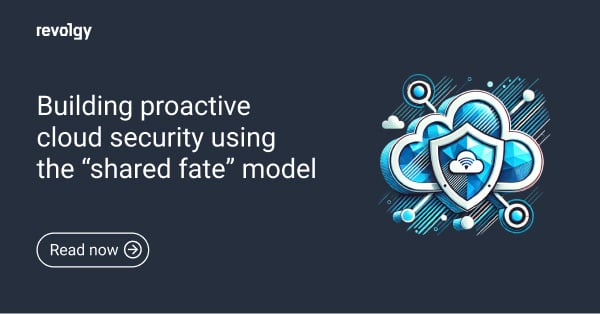Cloud Platform Services, Security
Avoid these 8 common cloud security pitfalls
When it comes to cloud security, even the tiniest missteps can lead to huge problems. Recent research at Revolgy shows that 90.6% of businesses view cloud security as a priority*, with nearly one in five seeing it as a critical area of their infrastructure in the next 12 months. Given these concerns, it’s more important than ever for organizations to recognize and avoid potential security pitfalls.
Here’s a rundown of eight common cloud security pitfalls and practical tips on how to avoid them.
1. Misconfiguration
One of the most common issues in cloud computing security is misconfiguration. With the cloud, you no longer have a single, secure perimeter protecting your assets. Instead, every cloud account or subscription — and even each workload — can have its own mini perimeter.
Misconfigurations can occur easily and leave your resources vulnerable. For instance, if you forget to set proper access controls on a storage bucket, you could inadvertently make sensitive data publicly accessible.
How to avoid misconfiguration:
Automate your configuration management using tools like Terraform or AWS CloudFormation. Regular audits can help catch misconfigurations before they cause problems. And don’t forget to set up alerts for configuration changes with AWS CloudTrail or similar tools for Google Cloud security.
2. Cloud credential creep
Cloud credential creep, also known as “cloud permissions sprawl,” refers to the gradual and often unnoticed accumulation of access rights, permissions, and credentials within a cloud environment. Over time, users, services, and applications may be granted more privileges than they need, leading to a complex and potentially insecure environment.
Managing cloud credentials can be tricky. Without proper oversight, you can end up with a sprawl of over-provisioned user accounts and roles, which attackers can exploit. This problem is different from that of on-premises environments because cloud IAM can quickly become complex with hundreds of roles and permissions.
How to avoid cloud credential creep:
Use multi-factor authentication (MFA) and a centrally managed identity provider (IDP). Implement role-based access controls (RBAC) to ensure users only have the access they need. Make use of IAM as code to manage policies, identities, and infrastructure consistently. Plus, you should regularly audit permissions and credentials to identify and remove unnecessary access rights.
3. Broken data plane access controls
Broken data plane access controls mean there are problems with the security rules that control who can use data in the cloud. The data plane is responsible for transmitting and handling data, such as read, write, update, or delete operations on cloud storage, databases, or other data resources.
Poorly configured data plane security can allow hackers to access your data, leading to data breaches. For instance, if passwords to access data are stored in an unsafe place, hackers can easily get them.
How to avoid broken data plane access controls:
Use centralized identity management and enforce policies through RBAC. Ensure all secrets and keys are stored in a secure vault with regular rotation. Educate your development teams to avoid high-privilege defaults and insecure key storage practices.
4. Exposed public endpoints
No one intentionally exposes endpoints to the public, but it happens more often than you’d think. Publicly accessible endpoints can be discovered quickly by malicious actors, making your applications vulnerable to attacks.
How to avoid exposed public endpoints:
Educate your teams about the risks of public endpoints and enforce strict review processes for provisioning publicly accessible assets. Use native cloud networking services like network security groups (NSG), access control lists (ACL), and firewalls to secure your IaaS and PaaS environments.
5. Neglecting compliance requirements
Cloud environments must adhere to various compliance and regulatory requirements, such as GDPR, HIPAA, and PCI-DSS. Failure to comply can result in hefty fines and damage to your reputation.
How to avoid compliance issues:
Perform compliance audits regularly and use automated tools to enforce compliance requirements. Educate your team about the importance of compliance and best practices to ensure everyone is on the same page.
6. Ignoring Cloud Security Posture Management (CSPM)
Cloud Security Posture Management (CSPM) is essential for maintaining a secure cloud environment. Many organizations overlook this aspect, leading to vulnerabilities that could have been easily mitigated.
How to avoid CSPM issues:
Invest in CSPM tools that provide continuous monitoring and auto-remediation of security issues. Integrate these tools into your CI/CD pipeline to catch misconfigurations early in development. Make CSPM a regular part of your security strategy to maintain a robust security posture.
7. Inadequate incident response planning
A solid incident response plan is an often overlooked aspect of cloud computing security. Many organizations are unprepared for breaches or attacks, leading to delayed responses and increased damage.
How to avoid inadequate incident response:
Develop and regularly update an incident response plan that includes specific procedures for cloud environments. Conduct regular drills and simulations to ensure your team is ready to respond swiftly and effectively. Utilize cloud-native tools for incident detection and response.
8. Overlooking shared responsibility model
Cloud providers operate under a shared responsibility model, meaning that while they secure the cloud infrastructure, customers are responsible for securing their data and applications within the cloud. Misunderstanding this can lead to gaps in security.
How to avoid overlooking shared responsibility model:
Clearly understand and define the shared responsibility model with your cloud provider. Ensure your security team knows their responsibilities and implements best practices to cover those areas. Regularly review and update your security policies to reflect this model.
Another option to secure your cloud is to work with a partner like Revolgy. Not only do we design and set up your infrastructure with the latest in cloud technology, but our AWS and Google Cloud certified cloud security engineers can manage your infrastructure 24/7 so you can focus on other aspects of your business. Contact us for a free consultation to learn more about our cloud security solutions and services.
*Based on responses from 160 attendees at the Google Cloud Summit in Prague in June 2024, our survey assessed the priority of various cloud areas for the next 12 months. 90.6% of respondents rated cloud security as a medium to critical priority.



